Last updated on December 6th, 2025 at 11:45 am
Reverse osmosis systems are crucial for treating wastewater and ensuring drinking water is clean and safe. However, being machines, they can experience some faults. Common reverse osmosis system problems arise because of a lack of scheduled maintenance, loose connections, unstable pressure in the RO tank, and glitches with the system’s valves. In this post, we’ll explain the causes and solutions of various common RO system problems.
How Does the RO System Work?
Osmosis is a process through which water flows from a less concentrated solution to a more concentrated solution. This creates an osmotic pressure. Reverse osmosis is the opposite of this process used to treat wastewater.
In a reverse osmosis system, a pressure higher than the osmotic pressure is given to a more concentrated solution. This solution is then made to flow via a semipermeable RO membrane. This membrane, which has tiny pores, allows the passage of water and eliminates all solids, no matter how small they are. Thus, the water that comes through the RO’s membrane is desalinated and free from impurities.
Causes and Fixes for RO System Problems
A reverse osmosis system consists of filters, membranes, valves, fittings, storage tanks, and feed pressure. Any issues with these components hinder the proper working of the RO system and lead to various problems.
1. Low Water Pressure or Flow
A slow water pressure and flow rate typically indicates an obstruction inside the RO system. Here are its causes and solutions.
Causes for Low Water Pressure
- Clogged and fouled RO membrane
- Ruptured air bladder in the storage tank
- Clogged carbon block, sediment, and GAC polishing filters
- Kinks and pinches in the water line
- Low pressure within the reverse osmosis system tank
- Temporary loss of RO water pressure
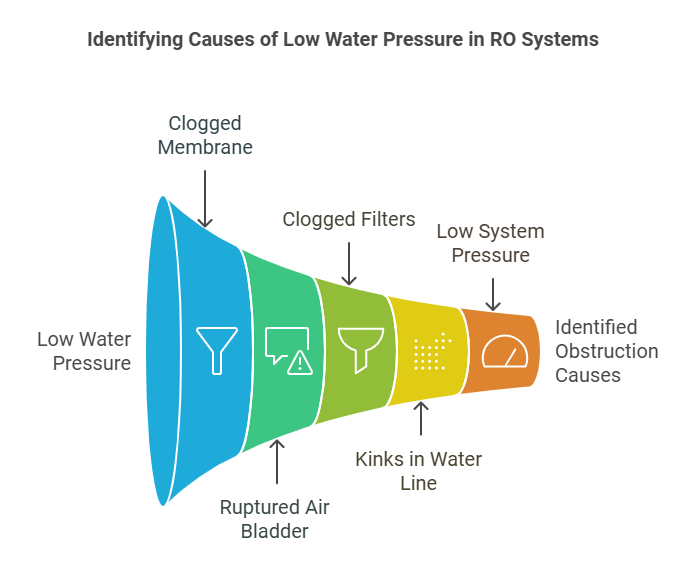
Troubleshooting for Low Water Pressure
- Check if the membrane is clogged. Remove the drain flow restrictor and let the water flow for 10 minutes. It will flush the membrane.
- If the membrane has not been replaced in a year, remove it and all other filters and sanitize the RO system. After that, replace the membrane and filters.
- Check if the air bladder is ruptured. Try to fill the air using an air compressor. If you cannot charge and maintain six psi air, replace the storage tank.
- Check if there are kinks in the water line. While doing so, keep the water supply line valve open.
- Finally, ensure that the water pressure in your facility is between 40-60 psi. If not, use a booster pump to bring the pressure to the required level.
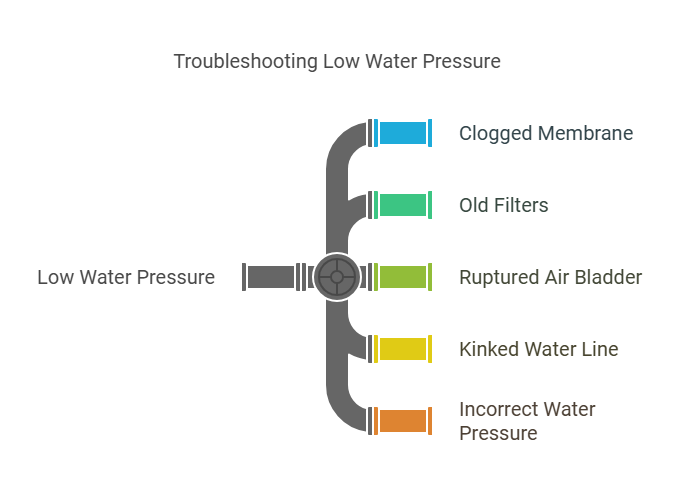
2. Bad Taste of Water
A high concentration of chemicals and organic matter in water makes it taste bad. The water can have sulfur, chlorine, or metallic taste.
Causes for Bad Tasting Water from RO
- Increased levels of carbon dioxide in the RO water make its taste bitter.
- High levels of hydrogen sulfide or methane in the water make it taste like rotten eggs.
- A high chlorine concentration makes the water taste acidic or ‘fuzzy.’
- If the life of the RO system’s filters has expired, water will taste tart. Another reason is the organic matter, like tannins, in large quantities.
- RO water with high TDS (total dissolved solids) tastes bitter.
- Other potential causes of bad tasting water include bacterial accumulation in the RO system, membranes damaged by impurities, dirty filters, and too high or low water pressure.
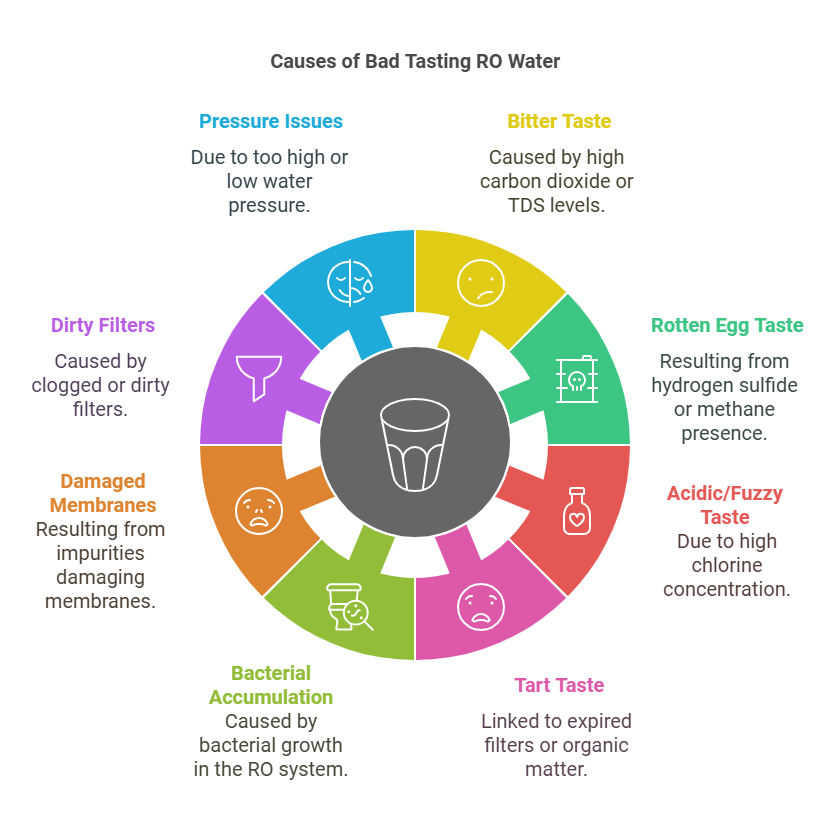
Troubleshooting for Bad Tasting Water
- Check the membrane, and if it is clogged or dirty, replace it.
- Sanitize the tank if you have not done so in the past six months.
- Drain the RO system if you have not used it for over five days.
- Chlorine bleach removes moderate to high levels of hydrogen sulfide in water. Also, clean the filters.
- Carbon block filters remove 98% of chlorine and its byproducts from RO systems.
- Use high-quality water filters to remove bad taste and odor from water. Ampac USA’s counter top water filter removes chlorine taste and organics from water and reduces metal and lead.
- Schedule professional maintenance of the RO system.
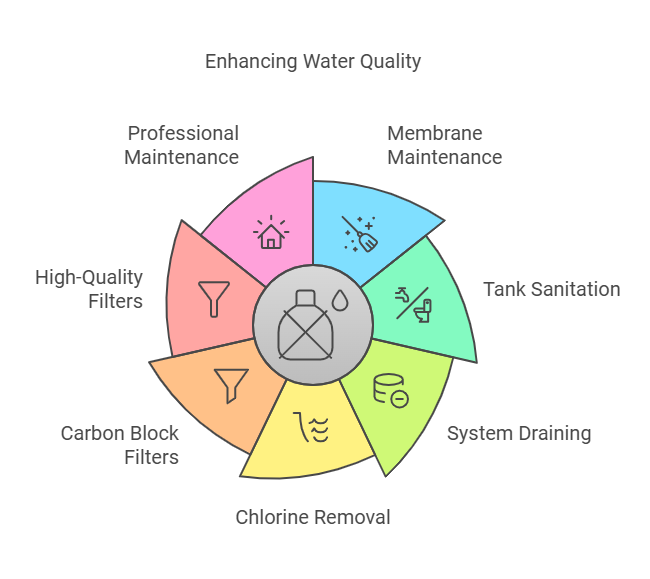
3. RO System Leaking
A reverse osmosis system can develop various types of leaks. Some common sites for leaks are filter connections or housings, air gap faucets, pipe connections, feed water adapters, and storage tanks. RO system problems related to leakage has specific causes according to the site of the leak.
Causes for RO System Leaks
- Loose fittings, reused, worn-out O-rings, and damage to the housing cause leaks in filter housings. Common signs include low water pressure, dripping water from the faucet, and moisture build-up.
- Improper installation of the RO system or high levels of contaminants in feed water cause air gap leaks. It obstructs the water’s flow, and it pours from the air gap hole.
- Loose fittings or worn-out tubings and damaged fittings cause leakages in pipe connections. Common signs include spots of water on the floor and a hissing sound near the pipes.
- A change of membranes or faulty O-ring seal leads to membrane housing leaks.
- A leak in the feed water adapter, the part that connects the main water supply to the reverse osmosis system, is due to loose connections, damaged cross-threaded fittings, and O-rings.
- Damaged bladder or incorrect fittings connecting to the RO system lead to storage tank leaks.
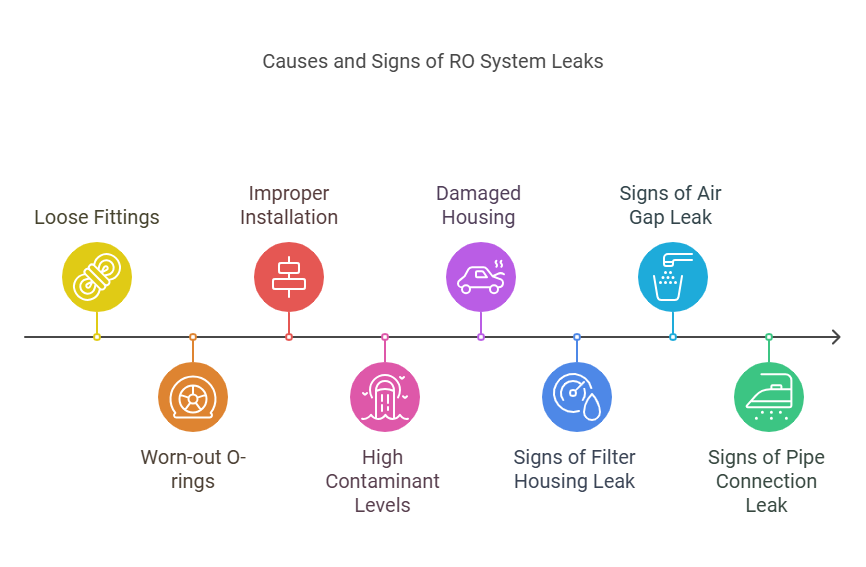
Other common causes for RO system leaks include improper installation of the water filter, unstable water pressure, and poor water quality.
Troubleshoot RO System Leaks
- Ensure that the O-rings are properly lubricated and placed where they need to be.
- Inspect for damage or cracks in pre-filter or membrane housings. Replace the housings if you detect damage.
- Inspect the different parts of the faucet, like washers and gaskets. If they are worn out, replace them.
- Try to fill the air in the storage tank bladder. If you cannot maintain six psi air, replace the tank.
- The tubing should be pushed entirely into the fitting for a proper seal. If it is scratched, it cannot be sealed, so you must replace it.
- Schedule inspections for wear and tear on gaskets and O-rings for leak prevention.
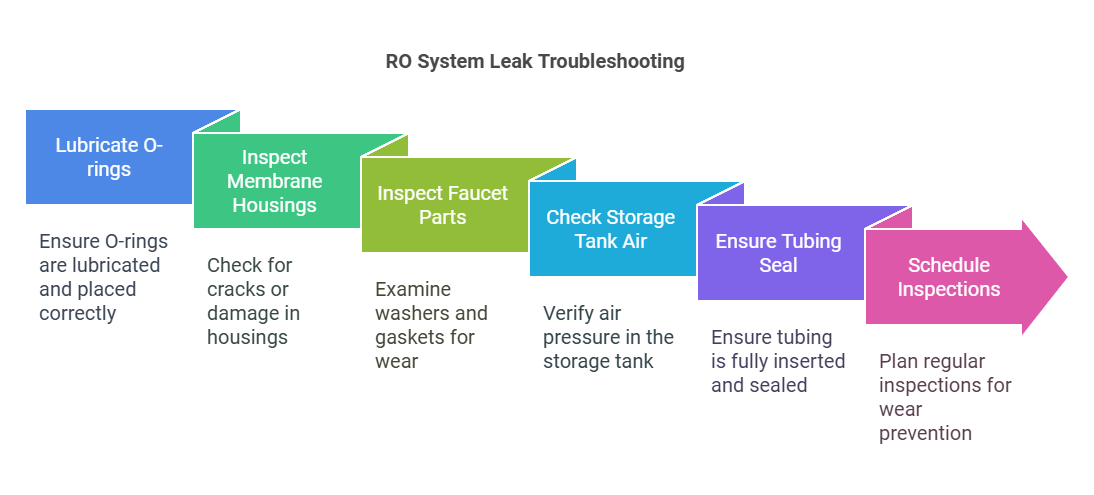
4. Noisy Drain or Faucet
One of the typical RO system problems is noise. Some people hear a humming noise, while others complain of a noisy gurgle. A hissing RO unit is another related problem. It’s perfectly normal to hear these sounds, but if they intensify, that’s when you should conduct RO troubleshooting.
Causes of Noisy Drain or Faucet
- The RO system makes noise when it is newly installed because of trapped air in the drain line or the check valve.
- A drain line that is too long or has an upward loop traps air and causes noise.
- Too low or high water pressure makes the RO system start repeatedly and make a noise.
- An issue with the contact of the high-voltage switch in the RO makes the water inlet valve start continuously, leading to continuous noise.
- Low water pressure in the supply line or disrupted water supply leads to noise because the RO purifier needs to be pressurized to push water through the membrane.
- Clogged filters and membranes obstruct water flow and lead to pressure build-up with the RO system, which causes noise.
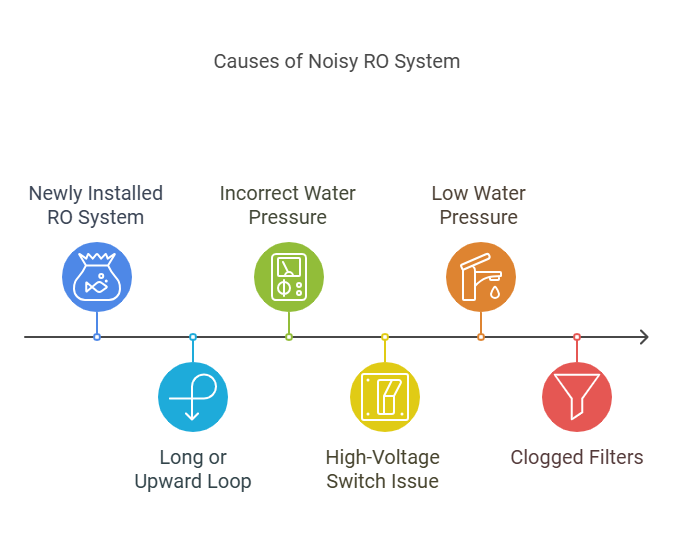
Troubleshoot Noisy Drain or Faucet
- Check the waterlines and ensure that it is free of damage.
- Relieve the air bubbles from the check valve by allowing water to pour through from the RO spigot.
- Replace worn-out filters and damaged parts like adapters, fittings, and valves.
- Replace clogged filters ad membranes or schedule their maintenance.
- Ensure that the placement of the RO purifier is stable.
- Invest in high-quality reverse osmosis systems designed with advanced technology that operate efficiently and quietly.
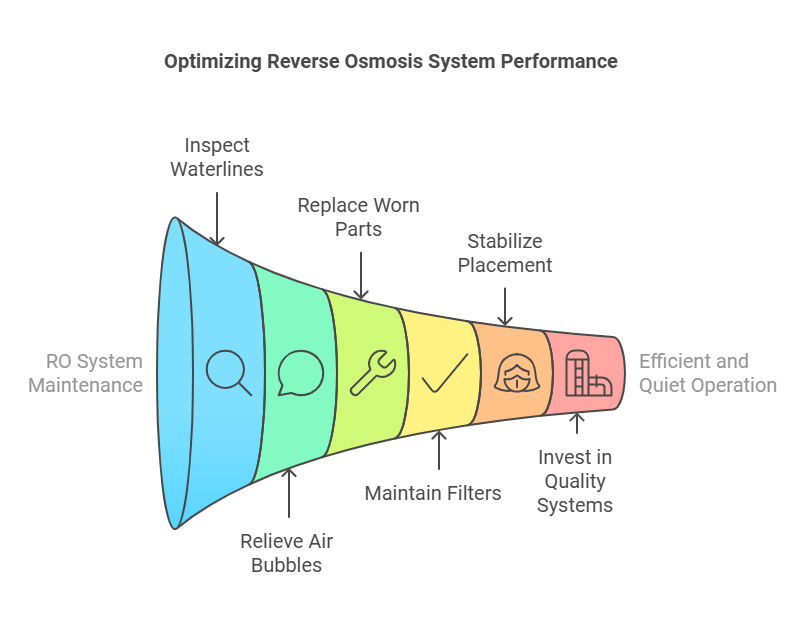
5. RO Storage Tank Not Filling Up
It’s a serious problem when the Reverse Osmosis storage tank does not fill up. It happens because of various reasons, but with a few checks, you can correct the issue.
Causes of RO Tank Not Filling
- Low water pressure in your home (below 40 psi)
- Clogged water supply valve
- A too-high or low pressure inside the RO tank.
- A ruptured tank bladder prevents the tank from holding water pressure
- Clogged pre and post-filters and flow restrictor
- The GPD (gallons per day) rate of your RO system is below 50 GPD
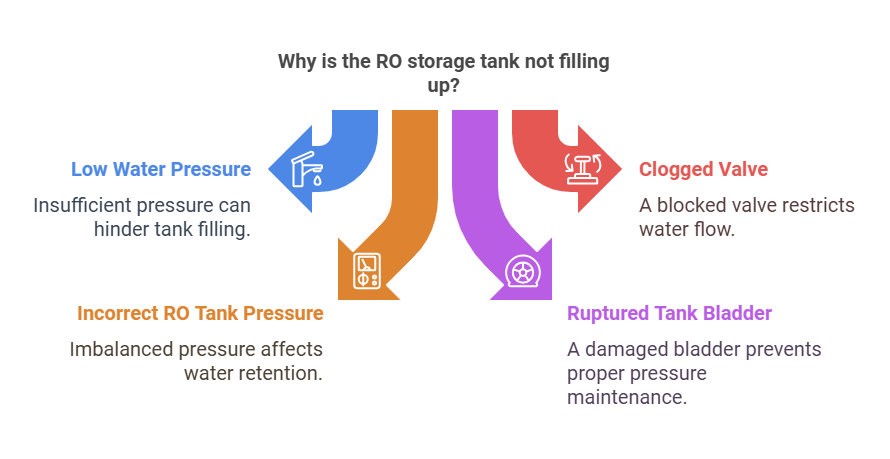
Troubleshooting RO Storage Tank Not Filling Up
- Check whether the water pressure is low in every faucet in your house. If yes, it’s a temporary problem that will resolve itself.
- Ensure that the water supply valve is not clogged or partially open. It should be fully open.
- Drain out all the water in the RO tank and inspect its pressure. Repressurize if the pressure is too low until it gets to 7 or 8 psi.
- Replace the storage tank if the tank bladder has been ruptured.
- Clean or change the carbon and sediment filters and the membrane
- Use a reverse osmosis system with a high water production rate, ranging from 100GPD to 1200 GPD.
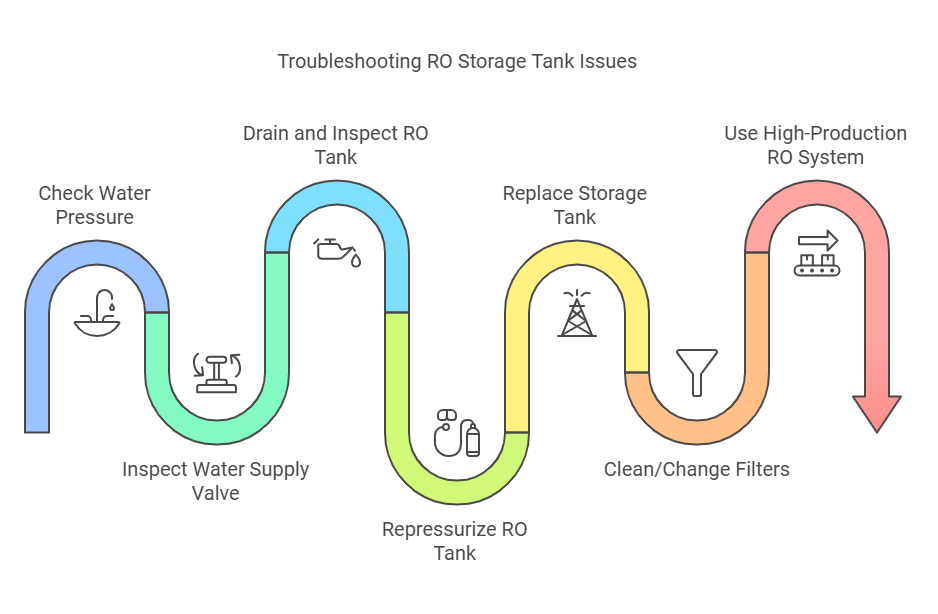
6. Continuous Draining of the RO System
Continuous or sporadic draining is one of the frequent reverse osmosis system problems that signals a glitch in the valves, clogging, or pressure issues in the tank. Sometimes, this problem persists even after you change the filters and membranes. Here’s what you should know about it.
Causes of RO System Continuously Draining
- A fault with the ASO or check valve makes the water continuously pass through the system.
- A missing or malfunctioning flow restrictor makes water constantly run to the drain.
- Clogged filers and membranes prevent the RO from working optimally.
- Unstable pressure in the tank
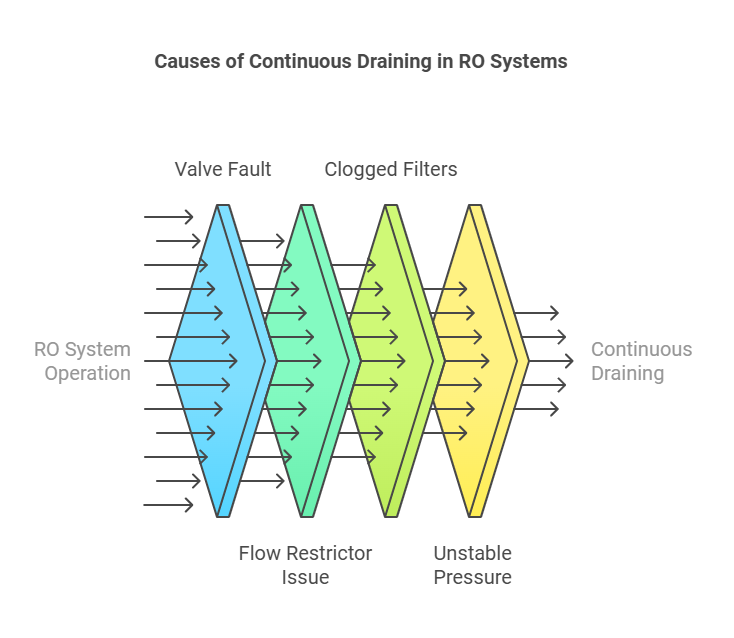
Troubleshooting Continuous Water Drainage
- Check that the residential water pressure is not below 40 psi. This level of pressure is crucial for the check valve to shut off and prevent water from draining.
- Ensure that the RO membrane and filters are in good condition.
- Inspect the pressure in the storage tank. If it’s below 7 to 8 psi, add air. If the pressure is too high, release some air.
- Draw two or three glasses of water from the faucet and then shut off the ball valve. It will simulate the tank being full.
- Wait for five minutes to allow the water to shut off. If it shuts off, it means that the ASO and check valves are working correctly.
- If the water does not shut off, it means that either the ASO or check valve is faulty.
- Now, to inspect the fault in the valves, shut off the water flowing to the reverse osmosis system.
- Check the black drain line for any water draining out from it. If yes, it is coming from the storage tank, indicating a broken check valve.
- If water does not flow from the drain line, it indicates a defective ASO valve. Replace the ASO valve, and while doing so, ensure that you replace the hoses carefully.
- Finally, tighten all the loose connections and replace damaged parts.
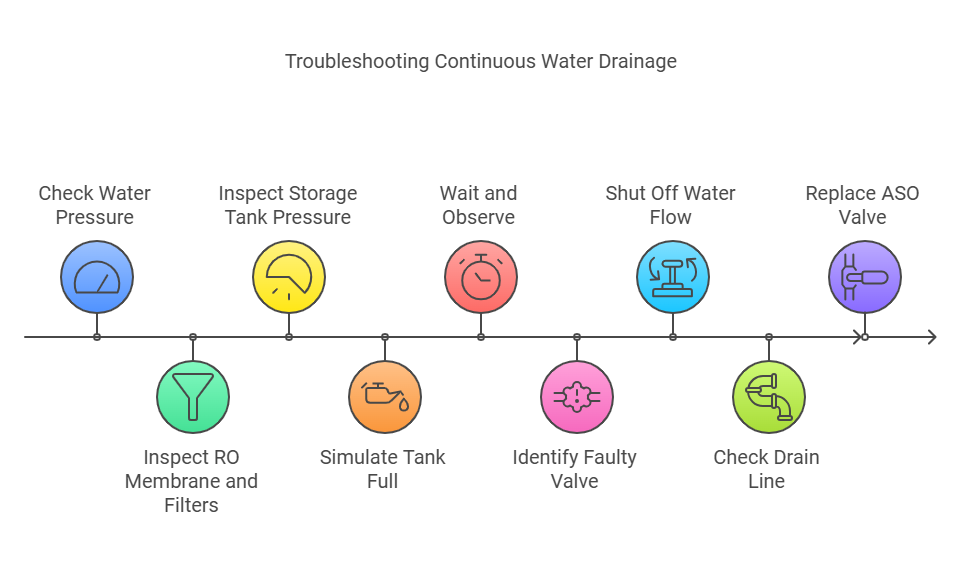
7. Milky and Cloudy Water
Milky or cloudy water is often considered one of the common RO system problems. However, it is not a grave issue because the water’s quality is not impacted. The issue only demands your attention when it’s because of a high TDS.
Causes of Milky and Cloudy RO Water
- Air trapped in the RO system.
- A filter replacement has introduced air into the water source.
- Insufficient filtration because of low water pressure makes the water cloudy.
- A high level of TDS prevents effective filtration and makes water milky with impurities.
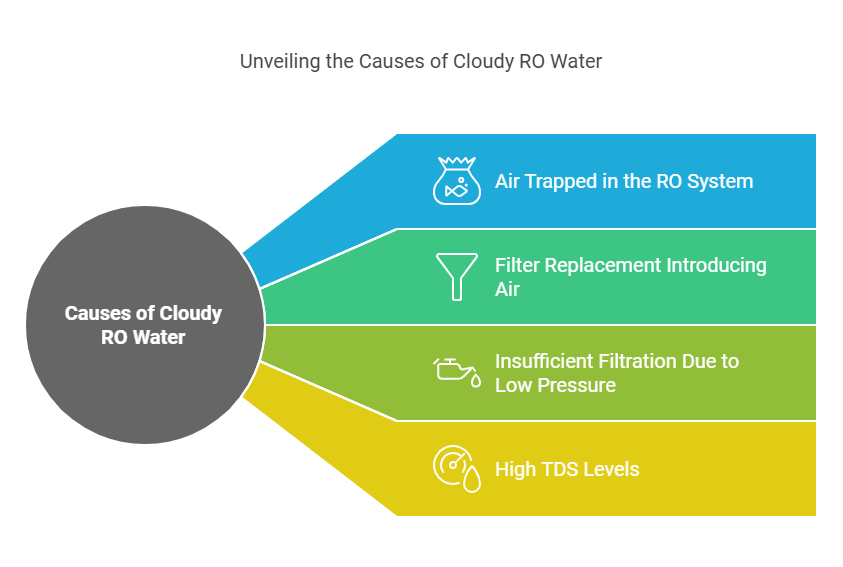
Troubleshooting Cloudy RO Water
- Remove air from the RO by tilting it to the right and letting water pour out of it. Do this at least three times to remove air and then check the water’s color.
- Ensure that the water pressure in your facility or house is not less than 40 psi. This facilitates effective filtration.
- Use a TDS meter to inspect the level of TDS in the RO-filtered water. If the TDS level is high, your RO’s filters are not working optimally to remove it.
- Look for RO systems that use RO+UV/UF with a TDS Controller. The different technologies remove dissolved impurities and make water ideal for consumption.
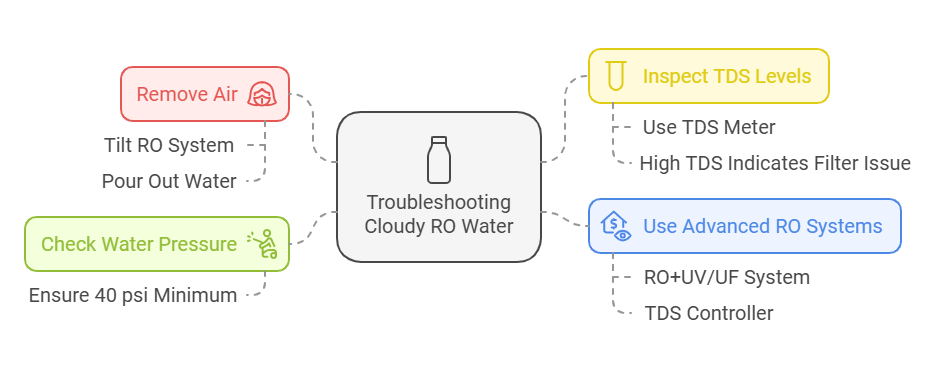
Conclusion
Reverse osmosis system problems can be frustrating, especially when you are not sure of the source of the problem. But after reading this post, you’ll gain a basic knowledge of how to troubleshoot common issues effectively. If you want to ensure efficient operation, invest in a high-quality RO system equipped with advanced filtration technologies. Also, ensure to schedule regular maintenance. Sanitize the RO system annually and change its filters every 6 to 12 months. A well-maintained system will easily last you for 15 years without many problems.

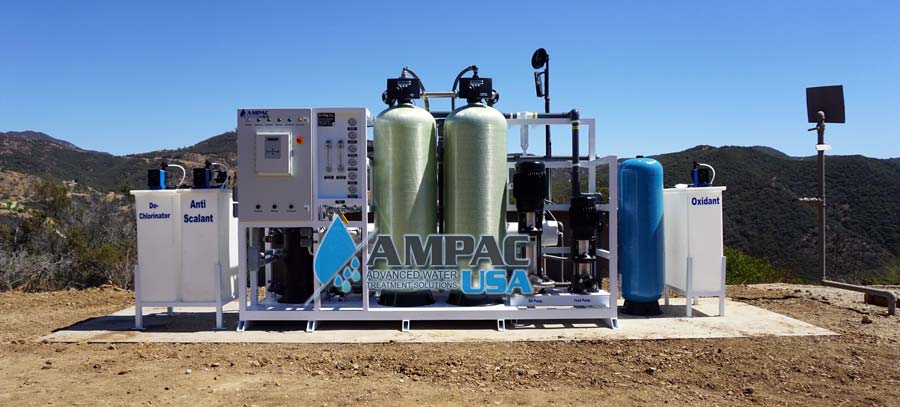










Thank you for writing this post. I like the subject too. http://www.kayswell.com
How can I find out more about it? http://www.kayswell.com
Thank you for being of assistance to me. I really loved this article. http://www.hairstylesvip.com
Please provide me with more details on the topic http://www.kayswell.com
Thank you for writing this article. I appreciate the subject too. http://www.kayswell.com
Touche. Outstanding arguments. Keep up the great work. http://www.kayswell.com
Somebody essentially assist to make critically posts I would state. That is the first time I frequented your website page and to this point? I amazed with the research you made to make this actual put up amazing. Magnificent task! http://www.kayswell.com
Hello my family member! I want to say that this post is amazing, great written and come with almost all significant infos. I would like to look more posts like this. http://www.kayswell.com
constantly i used to read smaller articles or reviews that also clear their motive,and that is also happening with this piece of writing which I am reading here. http://www.kayswell.com
Ahaa, its good dialogue regarding this article at this place at this website, I have read all that, so at this time me also commenting here. http://www.hairstylesvip.com
constantly i used to read smaller articles or reviews that also clear their motive,and that is also happening with this piece of writing which I am reading here. http://www.kayswell.com
If you want to increase your experience just keep visiting this site and be updated with the most up-to-date news update posted here. http://www.kayswell.com
Hey there fantastic blog! Does running a blog similar http://www.kayswell.com
Hi there, its fastidious article concerning media print, we all be aware of media is a great source of data. http://www.kayswell.com
Hello colleagues, its enormous article regarding cultureand completely defined, keep it up all the time. http://www.kayswell.com
Great post. I was checking constantly this blog and I am impressed! Extremely useful information specifically the last part 🙂 I care for such information a lot. I was seeking this certain info for a long time. Thank you and good luck. http://www.kayswell.com
Ahaa, its fastidious discussion on the topic of this article at this place at this website, I have read all that, so now me also commenting at this place. http://www.kayswell.com
I’m not sure if this is a format issue or something to do with internet browser compatibility but I figured I’d post to let you know. The style and design look great though! Hope you get the issue fixed soon. Many thanks http://www.kayswell.com
Thank you for any other fantastic article. The place else may anyone get that type of info in such an ideal means of writing? I have a presentation subsequent week, and I’m at the search for such information. http://www.kayswell.com
to this require a great deal of work? I have very little knowledge of computer programming however I had been hoping to start my own blog in the near future. Anyway, should you have any suggestions or tips for new blog owners please share. http://www.hairstylesvip.com I understand this is off topic but I simply needed to ask.
Hello my family member! I want to say that this post is amazing, great written and come with almost all significant infos. I would like to look more posts like this. http://www.kayswell.com
Thanks for one’s marvelous posting! I truly enjoyed reading it, you are a great author.I will ensure that I bookmark your blog and will often come back in the future. http://www.hairstylesvip.com I want to encourage you to definitely continue your great posts, have a nice day!
I’ve been surfing online more than 3 hours today, yet I never found any interesting article like yours. It’s pretty worth enough for me. Personally, if all webmasters and bloggers made good content as you did, the web will be much more useful than ever before. http://www.kayswell.com
Hi every one, here every person is sharing these kinds of knowledge, therefore it’s good to read this blog, and I used to pay a quick visit this blog daily. http://www.kayswell.com
This piece of writing will help the internet visitors for creating new web site or even a blog from start to end. http://www.ifashionstyles.com
Really when someone doesn’t be aware of afterward its up to other viewers that they will help, so here it occurs. http://www.kayswell.com
This is a topic that’s near to my heart… Many thanks! Where are your contact details though?
First off I would like to say superb blog! I had a quick question which I’d like to ask if you don’t mind. I was interested to find out how you center yourself and clear your thoughts before writing. http://www.kayswell.com I have had a difficult time clearing my mind in getting my ideas out there.I truly do take pleasure in writing but it just seems like the first 10 to 15 minutes are
Hello mates, nice article and fastidious urging commented here, I am actually enjoying by these. http://www.hairstylesvip.com
Ahaa, its fastidious discussion on the topic of this article at this place at this website, I have read all that, so now me also commenting at this place. http://www.hairstylesvip.com
Oh my goodness! Amazing article dude! Many thanks, However I am encountering problems with your RSS. I don’t understand the reason why I can’t join it. Is there anybody else having similar RSS issues? Anyone who knows the answer can you kindly respond? http://www.kayswell.com
Heya i am for the first time here. I found this board and I to find It truly helpful & it helped me out much. I hope to offer one thing back and help others like you aided me. http://www.kayswell.com
Ahaa, its fastidious discussion on the topic of this article at this place at this website, I have read all that, so now me also commenting at this place. http://www.kayswell.com
I think the admin of this website is in fact working hard in support of his website, as here every stuff is quality based stuff. http://www.kayswell.com
Good write-up. I certainly appreciate this website. Keep it up! http://www.kayswell.com
You should be a part of a contest for one of the finest blogs on the net. I’m going to highly recommend this blog! http://www.kayswell.com
I’m curious to find out what blog system you have been using? I’m experiencing some small security issues with my latest blog and I’d like to find something more safe. Do you have any suggestions? http://www.kayswell.com
Thank you for any other fantastic article. The place else may anyone get that type of info in such an ideal means of writing? I have a presentation subsequent week, and I’m at the search for such information. http://www.kayswell.com
лента для окон пвх самоклеющаяся [url=https://samokleyushchayasya-plenka-1.ru/]лента для окон пвх самоклеющаяся[/url] .
современная дизайнерская мебель купить [url=https://dizajnerskaya-mebel-1.ru/]современная дизайнерская мебель купить[/url] .
What’s Going down i’m new to this, I stumbled upon this I have discovered It absolutely useful and it has aided me out loads. I am hoping to give a contribution & assist other users like its helped me. http://www.hairstylesvip.com Great job.
Greetings! Very helpful advice in this particular article! It’s the little changes that will make the most significant changes. Thanks a lot for sharing!
Somebody essentially assist to make critically posts I would state. That is the first time I frequented your website page and to this point? I amazed with the research you made to make this actual put up amazing. Magnificent task!
Thanks for your write-up on this website. From my own personal experience, occasionally softening up a photograph may provide the photography with a little an artsy flare. More often than not however, this soft cloud isn’t just what exactly you had in mind and can usually spoil an otherwise good photograph, especially if you intend on enlarging them.
установка кондиционера в обнинске стоимость [url=http://www.kondicioner-obninsk-1.ru]установка кондиционера в обнинске стоимость[/url] .
стоимость м2 натяжного потолка [url=https://natyazhnye-potolki-lipeck-1.ru]стоимость м2 натяжного потолка[/url] .
Good write-up. I certainly appreciate this website. Keep it up!
I really like what you guys tend to be up too. This kind of clever work and reporting! Keep up the amazing works guys I’ve added you guys to my blogroll. http://www.kayswell.com
I am really loving the theme/design of your weblog. Do you ever run into any browser compatibility issues? A few of my blog readers have complained about my site not working correctly in Explorer but looks great in Firefox. Do you have any advice to help fix this issue? http://www.kayswell.com
Hello There. I found your blog the use of msn. This is a really well written article. I will make sure to bookmark it and come back to read extra of your useful info. Thanks for the post.
I just like the valuable information you provide on your articles.I’ll bookmark your blog and test again here frequently. I’m quite certain I’ll be informed plenty of new stuff proper right here! http://www.kayswell.com Good luck for the next!
What’s Going down i’m new to this, I stumbled upon this I have discovered It absolutely useful and it has aided me out loads. I am hoping to give a contribution & assist other users like its helped me. Great job.
Hello mates, nice article and fastidious urging commented here, I am actually enjoying by these. http://www.kayswell.com
Greetings! Very helpful advice in this particular post! It is the little changes that produce the biggest changes. Thanks a lot for sharing!
I’m curious to find out what blog system you have been using? I’m experiencing some small security issues with my latest blog and I’d like to find something more safe. Do you have any suggestions?
Greate article. Keep posting such kind of info on your site. Im really impressed by your site. Hi there, You have done an excellent job. I’ll definitely digg it and individually suggest to my friends. I am sure they will be benefited from this web site.
Hello mates, its wonderful post on the topic of cultureand entirely explained, keep it up all the time. http://www.ifashionstyles.com
Hi, Neat post. There is a problem with your site in web explorer, might test this? IE still is the market chief and a large component of other people will leave out your wonderful writing because of this problem.
You made some good points there. I did a search on the issue and found most guys will agree with your blog.
Heya i am for the first time here. I found this board and I to find It truly helpful & it helped me out much. I hope to offer one thing back and help others like you aided me.
Hello everyone, it’s my first pay a visit at this website, and paragraph is in fact fruitful in support of me, keep up posting these types of articles.
Thanks , I’ve just been looking for information approximately this topic for a while and yours is the greatest I’ve found out so far. But, what about the conclusion? Are you certain about the supply? http://www.ifashionstyles.com
It’s a pity you don’t have a donate button! I’d definitely donate to this fantastic blog! I guess for now i’ll settle for bookmarking and adding your RSS feed to my Google account. I look forward to new updates and will share this blog with my Facebook group. Talk soon! http://www.kayswell.com
That is a very good tip especially to those new to the blogosphere. Short but very accurate information… Many thanks for sharing this one. A must read article! http://www.kayswell.com
Ahaa, its pleasant dialogue on the topic of this piece of writing here at this web site, I have read all that,so at this time me also commenting at this place. http://www.kayswell.com
This is the right webpage for anybody who wishes to understand this topic. You realize so much its almost tough to argue with you (not that I really will need to…HaHa). You certainly put a fresh spin on a topic which has been discussed for ages. Excellent stuff, just wonderful!
Sweet blog! I found it while searching on Yahoo News. Do you have any tips on how to get listed in Yahoo News?I’ve been trying for a while but I never seem to get there! Many thanks
That is really interesting, You’re an overly professional blogger. I’ve joined your rss feed and look forward to in the hunt for extra of your great post. Also, I have shared your web site in my social networks!
First off I would like to say superb blog! I had a quick question which I’d like to ask if you don’t mind. I was interested to find out how you center yourself and clear your thoughts before writing. http://www.kayswell.com I have had a difficult time clearing my mind in getting my ideas out there.I truly do take pleasure in writing but it just seems like the first 10 to 15 minutes are
Ahaa, its fastidious discussion on the topic of this article at this place at this website, I have read all that, so now me also commenting at this place. http://www.ifashionstyles.com
I’m not that much of a internet reader to be honest but your blogs really nice, keep it up! I’ll go ahead and bookmark your site to come back down the road. Many thanks http://www.kayswell.com
After exploring a few of the blog articles on your site, I seriously like your technique of blogging. I book-marked it to my bookmark webpage list and will be checking back soon. Take a look at my website as well and let me know what you think.
This information is true
——
buy kenya virtual phone number online https://virtual-local-numbers.com/countries/90-kenya.html for calls, sms, registration (otp)
I’m really enjoying the design and layout of your blog. It’s a very easy on the eyes which makes it much more enjoyable for me to come here and visit more often. Did you hire out a developer to create your theme? Excellent work!
Do you mind if I quote a few of your articles as long as I provide credit and sources back to your website? My website is in the exact same area of interest as yours and my visitors would definitely benefit from some of the information you provide here.
Hi there to every one, since I am really eager of reading this blog’s post to be updated on a regular basis. It includes fastidious data. http://www.hairstylesvip.com
I like the valuable info you provide to your articles. I will bookmark your weblog and check once more here regularly. I am reasonably sure I’ll be told lots of new stuff proper right here! Best of luck for the following!
I do agree with all of the concepts you’ve introducedon your post. They’re really convincing and will definitely work.Nonetheless, the posts are very brief for newbies.May just you please extend them a bit from subsequent time?Thanks for the post. http://www.hairstylesvip.com
If some one desires expert view concerning blogging afterward i advise him/her to pay a visit this weblog, Keep up the good work.
Have you ever thought about adding a little bit more than just your articles? I mean, what you say is valuable and everything. Nevertheless think about if you added some great pictures or video clips to give your posts more, “pop”! Your content is excellent but with pics and videos, this site could certainly be one of the best in its niche. Terrific blog!
It’s in point of fact a great and useful piece of info.I am glad that you just shared this useful info with us.Please keep us informed like this. Thanks for sharing.
Very nice post. I just stumbled upon your weblog and wished to say that I’ve truly enjoyed surfing around your blog posts. After all I will be subscribing to your feed and I hope you write again very soon!
Right now it sounds like WordPress is the preferred blogging platform out there right now. (from what I’ve read) Is that what you are using on your blog?
Hi to every body, it’s my first pay a visit of this weblog; this weblog contains remarkable and genuinely excellent material designed for readers.
Your mode of explaining everything in this piece of writing is genuinely pleasant, every one be capable of simply be aware of it, Thanks a lot.
Way cool! Some very valid points! I appreciate you penning
this write-up plus the rest of the website is very good.
Hello, I enjoy reading all of your post. I wanted to write a little comment to support you.
Ahaa, its pleasant dialogue on the topic of this piece of writing here at this web site, I have read all that,so at this time me also commenting at this place.
Hey there! Would you mind if I share your blog with my myspace group? There’s a lot of people that I think would really enjoy your content. Please let me know. Thanks http://www.hairstylesvip.com
Fantastic blog! Do you have any tips for aspiring writers? I’m planning to start my own website soon but I’m a little lost on everything. Would you suggest starting with a free platform like WordPress or go for a paid option? There are so many options out there that I’m totally confused .. Any ideas?
I am genuinely thankful to the owner of this web page who has shared this fantastic post at here.
Do you mind if I quote a few of your articles as long as I provide credit and sources back to your website? My website is in the exact same area of interest as yours and my visitors would definitely benefit from some of the information you provide here.